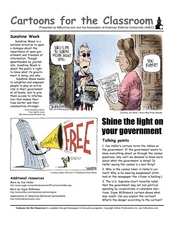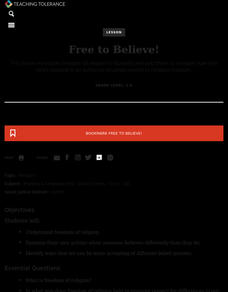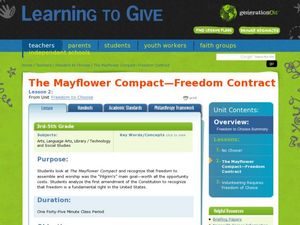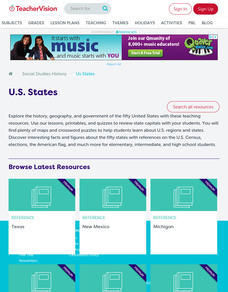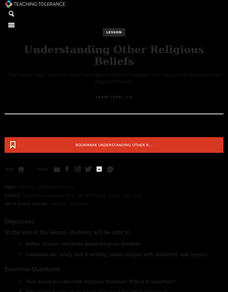Curated OER
American Focus on World Constitutions
High schoolers describe demographic, economic, political and geographic features of the U.S., summarize events leading to the creation of the Constitution and describe the process of amending the Constitution.
Curated OER
The Bill of Rights
Seventh graders determine why the Bill of Rights was added to the Constitution. In this U.S. government lesson, 7th graders discuss the first 10 amendments and any vocabulary they may be unfamiliar with. Students then read different...
Curated OER
U.S. Voting Amendments: Crossword Puzzle
In this United States history learning exercise, students use the 13 clues in order to fill in the crossword puzzle with the appropriate voting Amendment answers.
Curated OER
Constitution
Ninth graders simulate a U.S. Supreme Court hearing concerning a First Amendment case about school prayer by participating in a hearing.
Curated OER
Teaching about the First Amendment
Students defend the Constitution against a group of Senators who decide that all media must be approved by the government, all Americans must take a loyalty oath, join an official U.S. religion and subscribe to approved clubs.
Curated OER
First Amendment: Crossword Puzzle
In this United States history worksheet, students use the 14 clues in order to fill in the crossword puzzle with the appropriate answers pertaining to the First Amendment.
Curated OER
Amending the Constitution
Students research the history of the process of amending the US Constitution to explain the latest amendment that failed on June 28, 2006. They complete the research and view images online.
Curated OER
What is Meant by Returning to Fundamental Principles?
What did the Founding Fathers mean by the importance of continually returning to fundamental principles? Your young historians will analyze a series of quotations illustrating the fundamental ideals and principles of the United States...
Curated OER
Cartoons for the Classroom: Shine the Light on Your Government
What don't we know about our government? Explore the concept of transparency and freedom of information throught this analysis handout, in which scholars examine 2 political cartoons. Background information provides context, explaining...
Curated OER
Voting and the U.S. Constitution (Past, Present, and Future), Part 2
Students analyze and discuss the 19th Amendment, and read the document, Why Women Want to Vote. Students illustrate statements from the handbill, then conduct a play about women's suffrage.
Curated OER
US Constitution
Think about the Bill of Rights and the Declaration of Independence with your budding historians. They analyze the importance of historical documents by examining several famous documents, and then they complete activities that check...
Curated OER
It's Your Right: A Civil Rights Brochure
Learners examine the US Constitution, Bill of Rights, and Supreme Court cases in order to broaden their understanding of the US Judicial System. They research a variety of textual and Internet resources to create a tri-fold brochure,...
Teaching Tolerance
Free to Believe!
The United States: One nation with countless religions. An interesting lesson focuses on the freedom of religion protected under the First Amendment. Academics learn why it is important to protect all religions, why there is a separation...
Curated OER
The Mayflower Compact: Freedom Contract
Students read historical documents. In this freedom lesson, students discuss the freedoms they have, such as whom to play with at recess, and how the pilgrims must have felt when they landed in America. Students read The Mayflower...
Curated OER
Government and Politics
After a class lesson the U.S. Constitution and its amendments, students can apply their knowledge to this activity. Several questions prompt students to add missing key terms, such as the year the Constitution was written and the number...
Curated OER
U.S. President: Facts
Students gather information from a chart. They become familiar with the names of the presidents of the United States. They complete a worksheet imbedded in this plan on the many facts associated with the Presidents.
Curated OER
Plessy V. Ferguson: "Separate but Equal," Equal Protection
Students explore the details and impact of the Plessy vs. Ferguson U.S. Supreme Court case. In this U.S. History lesson, students participate in several group discussions and group activities that examine both sides of the famous...
Curated OER
School Bill of Rights
Students study the Bill of Rights. As a class, they create a "School Bill of Rights," with amendments. Students discuss the difference between rights and responsibilities and examine Supreme Court decisions dealing with the first ten...
Curated OER
The Constitution
Students use both electronic and traditional resources to research information about U.S. Constitution, answer questions pertaining to Congress and the Presidency, and design HyperStudio presentation to display answers to research...
Teaching Tolerance
Parallels Between Mass Incarceration and Jim Crow
Is history repeating itself? A riveting lesson examines the parallels between mass incarceration in the U.S. and the Jim Crow Laws of the past. Academics review Jim Crow Laws and compare them to mass incarcerations of African Americans....
Teaching Tolerance
Understanding Other Religious Beliefs
Learn what it means to respect others in an engaging instructional activity on religious beliefs. An inclusive resource focuses on understanding other religious beliefs, the right to freedom of religion, and the U.S. history of religious...
Anti-Defamation League
The Road to Brown
As part of the study of segregation in U.S. schools, scholars research and create a timeline of events that led to the historic Supreme Court case, Brown V. Board of Education. Groups research a topic or event that led to the decision,...
Curated OER
Constitution Day
In this crossword puzzle worksheet, students find 20 terms related to the Constitution by reading the clues and complete the puzzle.
Curated OER
Representation of the Common Citizen From Declaration of Independence to Present
Students create working definition of common citizen, and investigate and discuss important sections of Declaration of Independence, Articles of Confederation, U.S. Constitution, Bill of Rights, and other Amendments. Students demonstrate...










